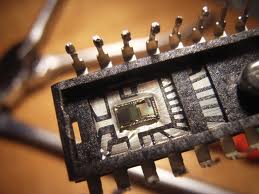Optical Sensors
Optical Sensors find applications in all sectors. They are used to detect luminous intensity, heat, presence, colour. Currently, most optical sensors are based on fibre optics or free space optics, but some new research deals with integrating sensor functions in photonic ICs. Plasmonics is a powerful technique for e.g molecular sensing. SPR-based sensing (Surface Plasmon Resonance) is a method that is both suitable and widespread in biotech labs for the ultra-sensitive detection of biochemical binding interactions of molecules to target structures tagged to a functionalised metallic surface. There is a need to standardise and control the sensitivity of photon-plasmon coupling. Specific chemical functionalisation of plasmonic nanostructures is one of the key challenges for application in the environmental monitoring and sensing field.
Uses
Sensors for sorting solid waste
Optical processes are sufficiently efficient to sort the waste but they are often in competition with other techniques. Optical technologies are generally more accurate and show great potential for the development of new processes (LIBS, neutron analysis, radio frequency detection, infrared thermograph pulsed laser ...)
Metrology and air monitoring
This emerging market will benefit from a favorable environment in the near future. The quality of indoor air is also a market in the making. Optical processes are widely used by the instruments of analysis of ambient air and detection of pollutants and dust in the air. Optical technologies used are for example the near IR optical absorption, the gas filter correlation, IR spectroscopy, Fourier Transform - FTIR, the LIDAR...
Water monitoring and treatment
This segment involves players with an international dimension and is therefore very attractive for the scale of its markets. The current needs in sensors, including optical sensors, are mainly related to the measurement of pressure, temperature but also gas detection, flow and bio-sensors for analysing water quality . It is important to know that the wastewater treatment and basic drinking water treatment are efficient against most of the bacteriological problems, but they do not remove the chemical contamination of nitrates, heavy metals, pesticides, endocrine disrupting compounds, and so one. Therefore, it is important to detect such pollutants, upstream, to alert users. The use of sensors based on the requirements and procedures for sampling and monitoring, the new generation of compact sensors, high autonomy, wireless, etc. should be integrated earlier in the chain of decision-making in order to regulate the environmental (weather) and health (control of water supplies) activities. Spectrometry IR / UV is widely used to check water quality but there are also other techniques for optical analysis of the water market. The measurement of dissolved oxygen levels using e.g. the principle of fluorescence is one of these. This technique tends to replace the membrane electrochemical sensors. The LIBS technique (measuring plasma optical emission induced by laser) also allows the analysis of liquid from a distance the detection of the presence of pollutants in real time.
Vegetal
A French company (Force A) has developed and commercialised the first optical sensor for the vegetal world and the real-time monitoring of crops. Based on the autofluorescence of leaves, they can quantitatively measure their aromatic compounds. The interest is to detect directly on the leaves and in real time, a lack of fertiliser or a plant pathogen attack. These sensors allow better management of inputs, give better quality products and thus contribute to environmental protection.
